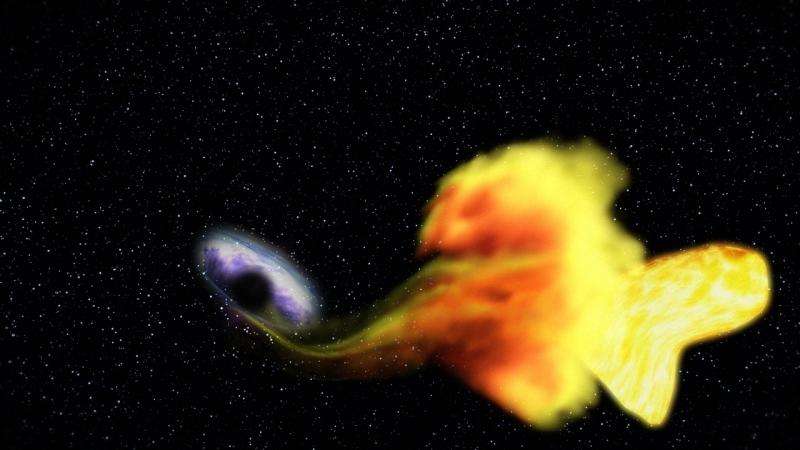Black holes might not be dead-ends after all

A physical body might be able to cross a wormhole in spite of the extreme tidal forces, suggests a new study by Rubiera-Garcia, of Instituto de Astrofísica e Ciências do Espaço (IA), and his team. This result, published on April 28 in the journal Classical and Quantum Gravity, is supported by the fact that the interactions between different parts of the body that hold it together are preserved. The team was invited by the journal editors to write an insight article that was published online today.
In their previous work, the authors arrived at theoretical descriptions of black holes without a singularity, the bizarre and infinitesimally small point where space and time ends abruptly. What they found at the centre of a black hole, and without actually being in search of one, was a spherical and finite sized wormhole structure.
Diego Rubiera-Garcia, of IA and Faculdade de Ciências da Universidade de Lisboa, commented on how the team solved the singularity problem: "What we did was to reconsider a fundamental question on the relation between the gravity and the underlying structure of space-time. In practical terms, we dropped one assumption that holds in general relativity, but there is no a priori reason for it to hold in extensions of this theory."
Presented with this wormhole structure of finite size, where space and time continue past and beyond the black hole and into another part of the universe, the authors then inquired about the fate of a physical object venturing into it. They asked if a chair, a scientist, or a spacecraft would withstand the intense gravitational field and retain physical unity through the journey, and also to what extent that body would be damaged.
In their study, a physical body approaching a black hole is analysed as an aggregation of points interconnected by physical or chemical interactions holding it together.
"Each particle of the observer follows a geodesic line determined by the gravitational field. Each geodesic feels a slightly different gravitational force, but the interactions among the constituents of the body could nonetheless sustain the body," Rubiera-Garcia said.
General relativity theory predicts that a body approaching a black hole will be crushed along one direction and stretched along another. As the wormhole radius is finite, the authors demonstrate that the body will be crushed to the size of the wormhole. Instead of converging to an infinitesimal separation, the so-called singularity, geodesic lines will still be separated by a distance greater than zero.
In their work, the authors show that the time spent by a light ray in a round trip between two parts of the body is always finite. Thus, different parts of the body will still establish physical or chemical interactions and, consequently, cause and effect still apply all the way across the throat of the wormhole.
We can then imagine that finite forces, no matter how strong they would have to be, could compensate for the impact of the gravitational field near and inside the wormhole on a physical body traversing it. At least, according to these study, the passage to another region of the universe might be feasible.
Francisco Lobo, of IA and Faculdade de Ciências da Universidade de Lisboa, leader of the Cosmology group at IA, said, "The authors' insights into the concepts of space-time singularities and curvature divergences are representative of the fundamental theoretical research carried out at the IA, going beyond Einstein's General Relativity. This research will also probably be important to understanding these difficult concepts for the fate of the universe in a plethora of cosmological models."
More information: Gonzalo J Olmo et al. Impact of curvature divergences on physical observers in a wormhole space–time with horizons, Classical and Quantum Gravity (2016). DOI: 10.1088/0264-9381/33/11/115007
Gonzalo J. Olmo et al. Geodesic completeness in a wormhole spacetime with horizons, Physical Review D (2015). DOI: 10.1103/PhysRevD.92.044047
Journal information: Physical Review D
Provided by Institute of Astrophysics and Space Sciences



















